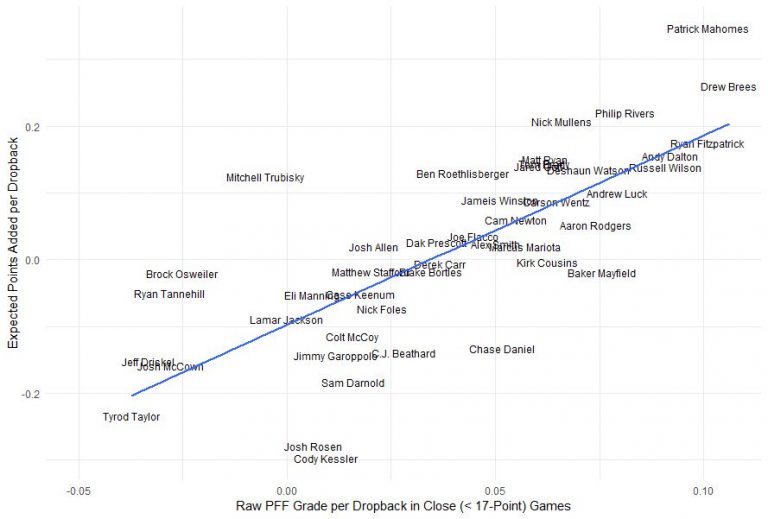Post by Funkytown on Jun 4, 2019 20:07:07 GMT -6
What do you guys think of the other NFCN QBs?
PFF: What the advanced analytics say about Bears QB Mitchell Trubisky
Link: www.profootballfocus.com/news/pro-what-the-advanced-analytics-say-about-mitchell-trubiksy
PFF: What the advanced analytics say about Bears QB Mitchell Trubisky
Understandably, Trubisky struggled in Year 1, failing to complete over 60% of his passes and throwing as many interceptions (seven) as touchdown passes. In a 2017 season that saw many injured quarterbacks and a generally down year offensively, the Bears were only 25th in expected points added on passing plays in Trubisky’s rookie year, even though the rookie was effective when he scrambled on said plays.
Out with John Fox and Dowell Loggins, in with Matt Nagy. Chicago’s passing offense took encouraging steps in Trubisky’s second year, earning the league’s 12th-best expected points added on passing plays (and ninth in Trubisky’s 14 starts). The quarterback’s box score statistics looked very impressive, as he completed almost two-thirds of his passes, threw for twice as many touchdowns (24) as interceptions and ran for another 421 yards.
However, we think this offensive production is likely in spite of Trubisky rather than because of him. During the course of 2018, we would tweet out graphics showing per-dropback PFF grades versus the expected points added by a passing offense, and Trubisky’s grade simply did not stack up to the production the offense was generating.

He ranked 32nd among passers in PFF grade from a clean pocket and 35th in percentage of dropbacks that earned a negative grade. The latter variable is the most stable we have when evaluating quarterbacks and is one from which a player usually does not rebound from one season to the next. He was 30th among quarterbacks in adjusted completion percentage, an accuracy measure that carries when looking at our ball-charting data, where he rated 30th in percentage of throws labeled “accurate” and 31st in percentage of throws labeled “catchable, but inaccurate” (as in he had relatively few of the former and many of the latter).
How could this be? First, it’s pretty clear that Nagy’s influence on the offense was a nontrivial one, covering up for much of the young quarterback’s deficiencies. Using our coaching rankings, he was top-10 offensive play caller from wire to wire in his first year. His main influence on the Bears’ passing offense was that, like in Kansas City, Nagy schemed Trubisky open throws at a rate 10 percentage points higher in 2018 than in 2017. In his first (partial) season calling plays for Kansas City in 2017, the notoriously middling Alex Smith led the NFL in passer rating during his age-33 season.
Another thing working in Trubisky’s favor was his supporting cast. Trubisky had clean pockets on over 70% of his dropbacks in 2018 — a top-10 mark at the position — while running back Tarik Cohen earned a top-five wins above replacement value at his position by averaging 2.37 yards per route run — the top mark among running backs. Only ten of Trubisky’s throws were dropped in 2018, the lowest number among quarterbacks who started more than 10 games.
Additionally, Chicago’s biggest deficit when Trubisky played was 14 points in week 3 against the Arizona Cardinals and Week 7 against the New England Patriots, deficits that were short-lived and rare due to the league’s best defense, meaning Trubisky was playing in an envious, 2017-Bortles-like situation as frequently as anyone.
Out with John Fox and Dowell Loggins, in with Matt Nagy. Chicago’s passing offense took encouraging steps in Trubisky’s second year, earning the league’s 12th-best expected points added on passing plays (and ninth in Trubisky’s 14 starts). The quarterback’s box score statistics looked very impressive, as he completed almost two-thirds of his passes, threw for twice as many touchdowns (24) as interceptions and ran for another 421 yards.
However, we think this offensive production is likely in spite of Trubisky rather than because of him. During the course of 2018, we would tweet out graphics showing per-dropback PFF grades versus the expected points added by a passing offense, and Trubisky’s grade simply did not stack up to the production the offense was generating.

He ranked 32nd among passers in PFF grade from a clean pocket and 35th in percentage of dropbacks that earned a negative grade. The latter variable is the most stable we have when evaluating quarterbacks and is one from which a player usually does not rebound from one season to the next. He was 30th among quarterbacks in adjusted completion percentage, an accuracy measure that carries when looking at our ball-charting data, where he rated 30th in percentage of throws labeled “accurate” and 31st in percentage of throws labeled “catchable, but inaccurate” (as in he had relatively few of the former and many of the latter).
How could this be? First, it’s pretty clear that Nagy’s influence on the offense was a nontrivial one, covering up for much of the young quarterback’s deficiencies. Using our coaching rankings, he was top-10 offensive play caller from wire to wire in his first year. His main influence on the Bears’ passing offense was that, like in Kansas City, Nagy schemed Trubisky open throws at a rate 10 percentage points higher in 2018 than in 2017. In his first (partial) season calling plays for Kansas City in 2017, the notoriously middling Alex Smith led the NFL in passer rating during his age-33 season.
Another thing working in Trubisky’s favor was his supporting cast. Trubisky had clean pockets on over 70% of his dropbacks in 2018 — a top-10 mark at the position — while running back Tarik Cohen earned a top-five wins above replacement value at his position by averaging 2.37 yards per route run — the top mark among running backs. Only ten of Trubisky’s throws were dropped in 2018, the lowest number among quarterbacks who started more than 10 games.
Additionally, Chicago’s biggest deficit when Trubisky played was 14 points in week 3 against the Arizona Cardinals and Week 7 against the New England Patriots, deficits that were short-lived and rare due to the league’s best defense, meaning Trubisky was playing in an envious, 2017-Bortles-like situation as frequently as anyone.
Link: www.profootballfocus.com/news/pro-what-the-advanced-analytics-say-about-mitchell-trubiksy






